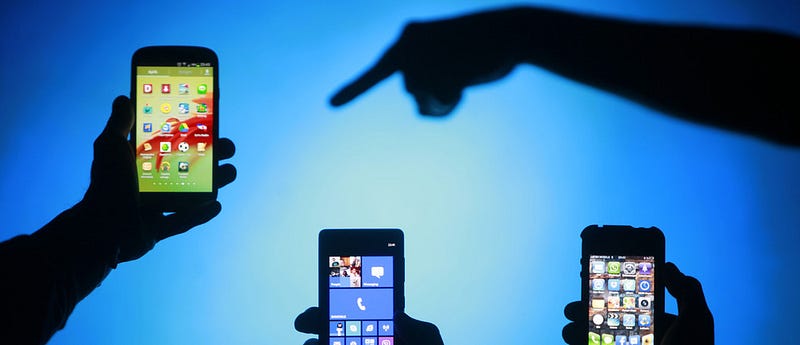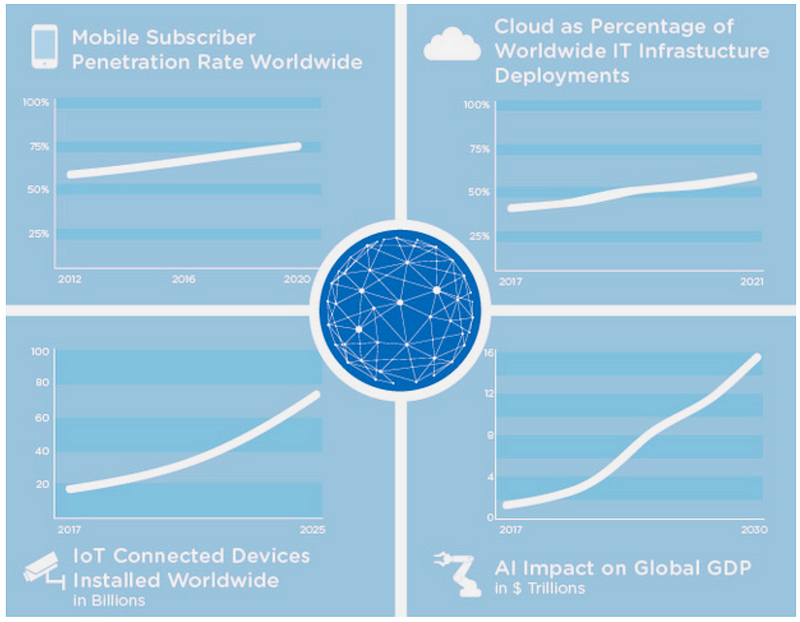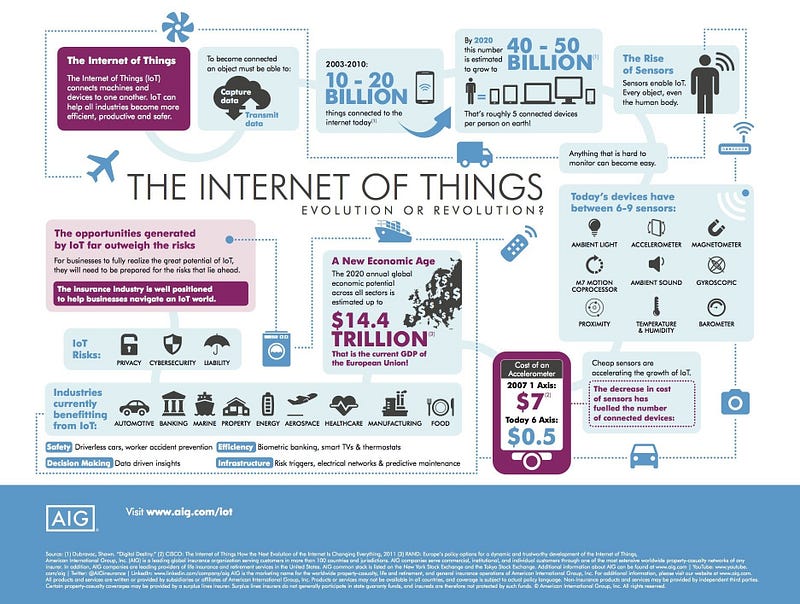Pat Gelsinger
 The term ‘superpowers’ conjures an image of major nations shaping the course of global history. But in the digital era, I believe it’s time we expanded that definition to include four extraordinary technological superpowers that promise to wield as much influence over the next 20 years as any nation state: mobile technology, the cloud, artificial intelligence (AI) and the internet of things (IoT). Each of these capabilities is transformative in its own right, but together they unlock game-changing opportunities that have not been available to us until this moment in history. And we are just beginning to tap their full potential.
The term ‘superpowers’ conjures an image of major nations shaping the course of global history. But in the digital era, I believe it’s time we expanded that definition to include four extraordinary technological superpowers that promise to wield as much influence over the next 20 years as any nation state: mobile technology, the cloud, artificial intelligence (AI) and the internet of things (IoT). Each of these capabilities is transformative in its own right, but together they unlock game-changing opportunities that have not been available to us until this moment in history. And we are just beginning to tap their full potential.
Mobile technology provides unprecedented reach, connecting people on the move no matter where they are in the world. The cloud delivers capacity on a previously unimaginable scale, enabling organisations to add or remove various components to their infrastructure quickly and as needed. Deep-learning AI enables us to mine massive amounts of data in real-time and to use those insights to dramatically accelerate academic discovery and create entirely new business models. And the IoT connects the physical and digital worlds, bringing technology into every dimension of human progress. As these innovations quickly mature and build on one another, they are reshaping every aspect of society, from healthcare to education to transport and financial inclusion.
 The global reach of these four tech superpowers is speeding up. Image: Pat Gelsing
The global reach of these four tech superpowers is speeding up. Image: Pat Gelsing
The question, then, is how do we ensure that these technological superpowers serve all of humanity? How can they improve the quality of life for all 7.6 billion people alive today (a figure expected to grow to 8.6 billion by 2030)? To put it another way: as technology breaks out and begins to exert a superpower-like influence globally, will all this innovation create a rising tide that lifts all boats, regardless of geography, background or culture? Or will the advantages it unleashes be limited to a fortunate few?
At my core, I’m a technologist and an optimist. After nearly four decades working in technology, I’m hopeful and energised about the future, and in the role technology will play in shaping it for the betterment of all. Technology itself is neutral — neither good nor bad. It’s about how we, as humans, apply it to the problems of the day. Here are a few specific examples of how these four technological superpowers are helping us address some of the big challenges we face as a global community.
1. Mobile: unprecedented reach
For millions of poor farmers living in remote areas around the world, access to an inexpensive mobile phone has transformed day-to-day life for their families and communities. A phone with basic internet service opens the door to micro-loans, real-time pricing for crops, accurate weather forecasts and information on topics like crop rotation, seeds and fertilisers — all adapted to local circumstances to help small farmers increase their yields in a sustainable way.
A recent MIT study conducted in Kenya found that access to mobile-money services lifted almost 200,000 families (2% of Kenya’s population) out of poverty between 2008 and 2014. Equally impressively, these mobile services have helped an estimated 185,000 female-headed Kenyan households become financially resilient by moving away from farming and into self-sustaining business occupations.
That’s the good news. The bad news is that in some of the poorest countries on Earth, less than 5% of the population has mobile internet access. We need to bring the power of mobile access and mobile money to the 2 billion people worldwide who still have no connection whatsoever to the financial system. The Gates Foundation’s initiative to drive interoperability across different mobile payment networks is a critical step in the right direction.
 The internet of things — one of four tech superpowers shaping our future. Image: AIG
The internet of things — one of four tech superpowers shaping our future. Image: AIG
2. Cloud: previously unimaginable scale
Today, 9 out of 10 organisations worldwide rely on the public cloud, as governments and private-sector businesses alike tap into the scale and flexibility which it provides. One of the best examples of its impact is in education, where massive open online courses (or MOOCs) are steadily opening up access to learning. The World Bank issued a warning recently on the learning crisis in global education, and it’s clear that in order for education to serve as a great equaliser, we need to invest in cloud-enabled educational models.
We’re still in the early stages of what we call the ‘digital economy’, but I believe we will continue to see big increases in remote employment opportunities as cloud-based infrastructure negates the need for large consolidated physical spaces for people to work. Online learning offers the best path to those jobs, especially for the billions globally who have no access to traditional forms of in-person education.
3. AI: intelligence everywhere
Artificial intelligence is delivering powerful insights fuelled by massive computing power, and in many ways we’re just getting started in this field. Look at the healthcare industry, where deep-learning algorithms are already creating breakthrough drugs, improving diagnosis and designing treatment plans far more effectively than any previous approach.
The field of prosthetics, for example, is on the brink of several major breakthroughs, in large part thanks to AI systems that are revolutionising care for people who have lost limbs. Researchers at Newcastle University in the UK have created a bionic “hand with eyes” that allows an amputee to reach for objects automatically and react without thinking — the same way that a real hand moves. This kind of innovation, enabled by the nascent AI industry, is only going to become more frequent.
4. IoT: Connecting the digital and physical worlds
At its most basic, the internet of things is about connecting a variety of physical objects into a network in which machines can communicate, including millions of embedded sensors that transmit data in real time. The IoT is already opening up exciting possibilities in areas as diverse as smart manufacturing, connected cars and smart energy grids.
For me, the most powerful aspect of IoT is its ability to help us clean up the aftermath of the industrial age, through smarter and more sustainable management of carbon, water and waste. Intelligent Assets, a recent report by the World Economic Forum and the Ellen MacArthur Foundation, shows powerfully how the Internet of Things has the potential to unlock extraordinary potential in the circular economy. Across every dimension of the complex environmental challenge that we face, IoT allows us to track and ‘sense’ the health of the planet with greater granularity and accuracy than ever before.
It is important to acknowledge that technology is not a panacea for all the problems we face. Yet as we work to address the big barriers to human progress and quality of life, technological innovation is the most powerful tool we have at our disposal. As technology elevates to superpower status, and the tech community comes of age, we must participate in a mature, thoughtful, and consistent way that acknowledges our individual and collective responsibility. Only by engaging, coming together and taking action in our own businesses, as well as shaping policy and regulatory frameworks, can we all work to ensure we ultimately maximise technology for the greater good.
Originally published at www.weforum.org.
No comments:
Post a Comment